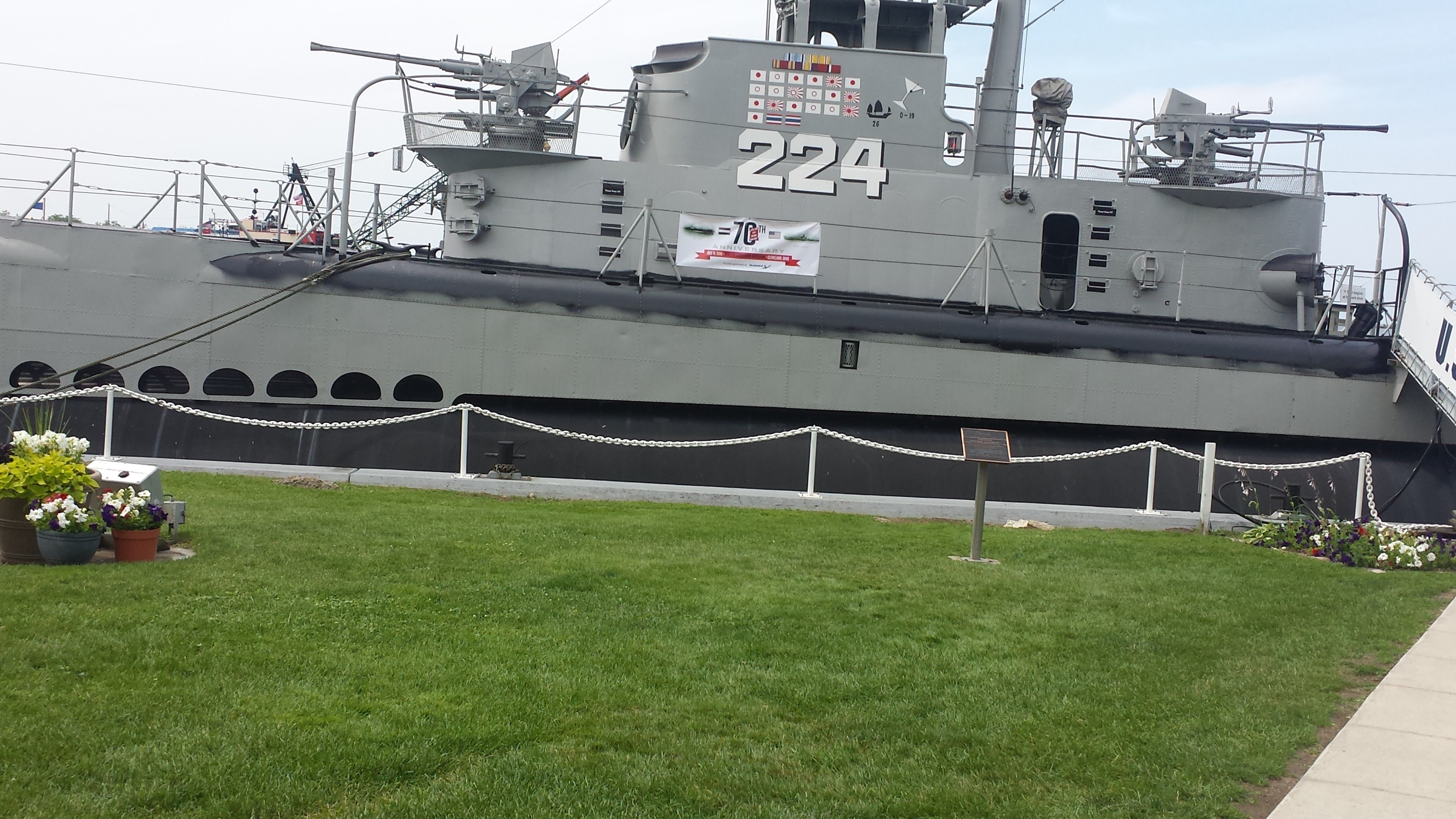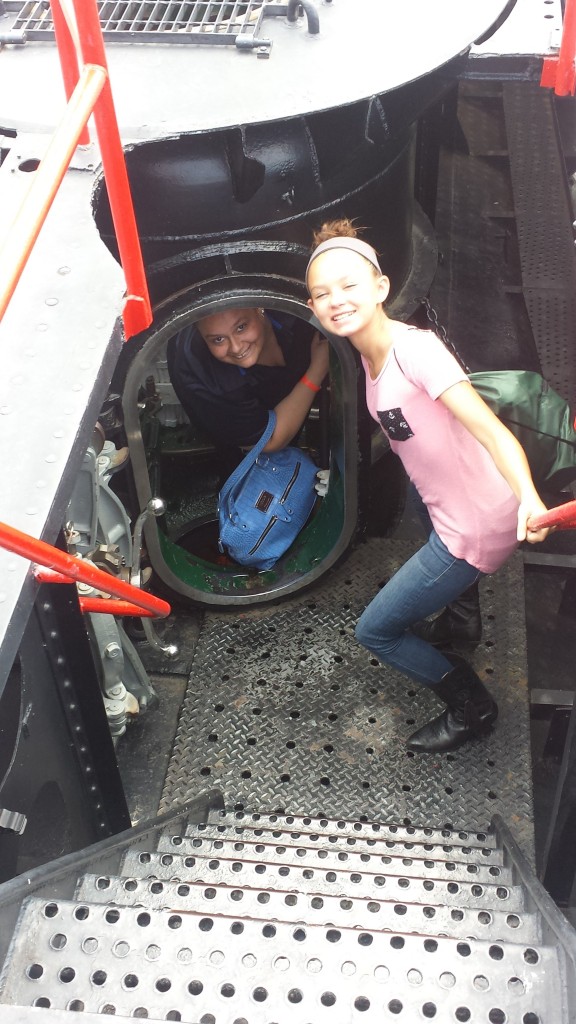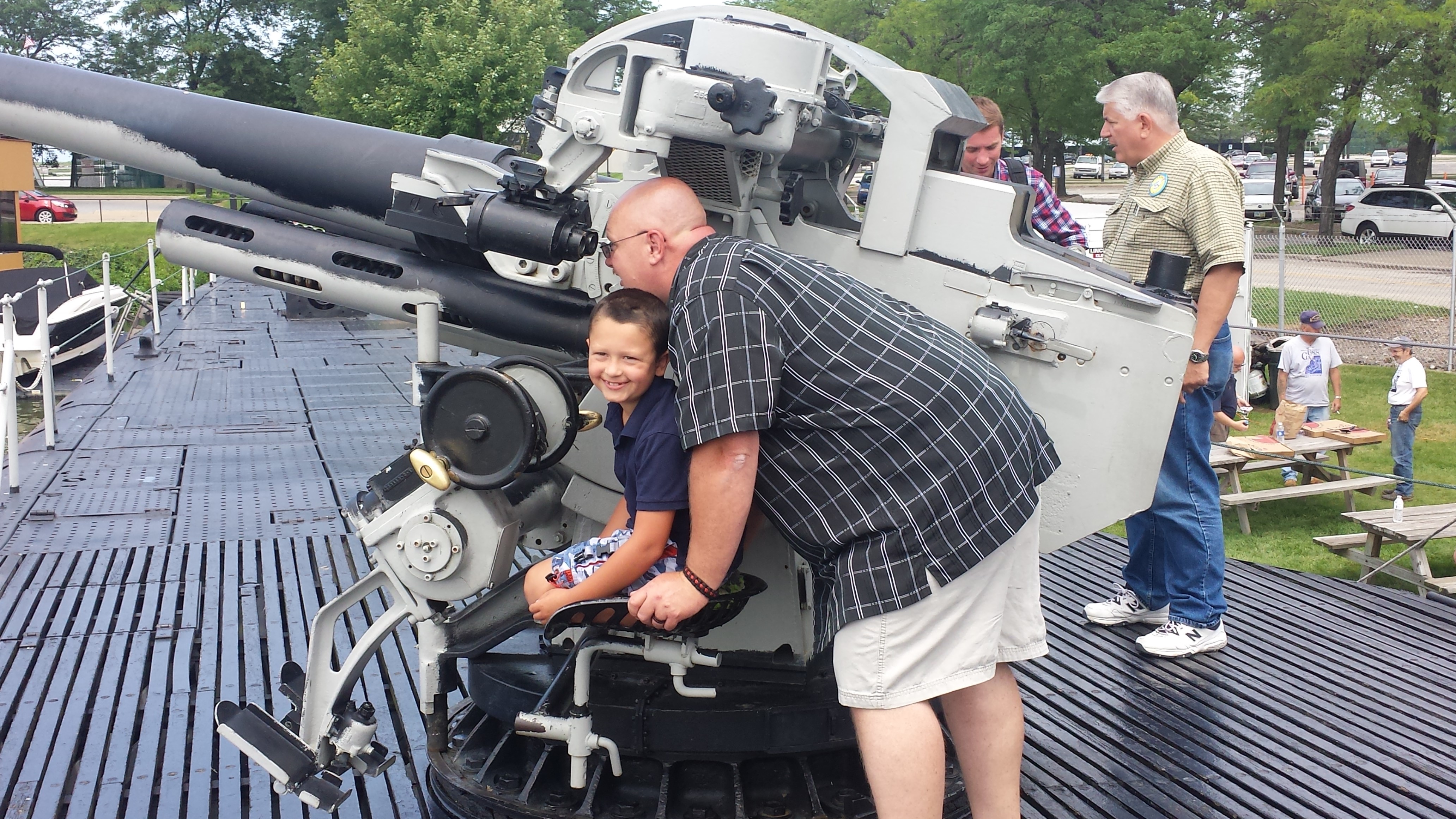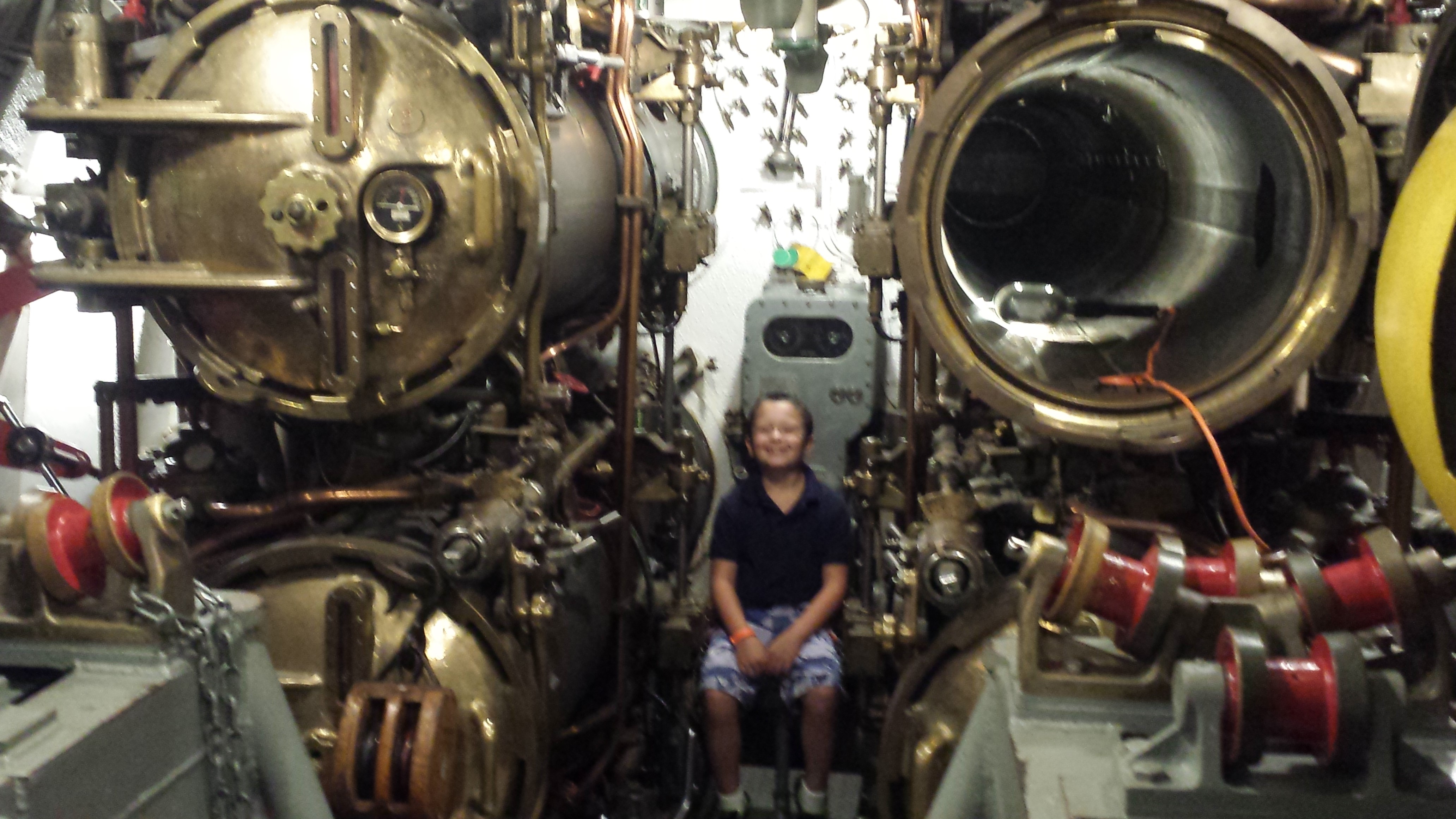
by Glenn R. Swift
Venerably moored at 1089 E. 9th St. in Cleveland, Ohio, on the banks of historic Lake Erie, the USS Cod Memorial brings an up close, hands-on feel of our nation’s proud history and serves as a living tribute to those who bravely answered the call of duty when an unprovoked enemy attacked us without warning three generations ago.
In her heyday, the Cod was a state-of-the-art submarine that played an integral part in helping to defeat the Imperial Japanese Navy in WWII by sinking 23 enemy vessels, the symbols of which are painted on the sub’s conning tower. The “boat” is open 9-5 to the public for guided tours from May 1 to September 30 for a modest donation: Adults $10; Seniors and Veterans $9; Students K-12 $6. (Children under 6 years with paying adult, military in uniform, and wives and family of active duty submariners are admitted free.) Visiting the Cod is a “must-do” for those with even the slightest curiosity of what it was like to be a crew member of a WWII submarine. For starters, while touring the Cod you can peer through the “boat’s” periscope and hear first-hand the heart-stopping alarm to “man battle stations” or conduct an emergency dive!
Beginnings
USS Cod was a Gato-class submarine, the only vessel of the United States Navy to be named for the cod, the world’s most important food fish and native to the waters of the North Atlantic and North Pacific. Her keel was laid down by the Electric Boat Company of Groton, Connecticut in July 1942. She was launched the following March and commissioned June 21, 1943 with Lieutenant Commander James C. Dempsey (Annapolis Class of 1931) in command.
 First and Second Patrols
First and Second Patrols
The Cod arrived in Brisbane, Australia, on October 2, 1943 to prepare for her first war patrol. She sailed from there 20 days later. Penetrating the South China Sea, she contacted few targets, launching an attack only once, on November 29, with unobserved results. Returning to Fremantle, Western Australia to refit from December 16, 1943 to January 11, 1944, Cod put to sea for her second war patrol in the South China Sea, off Java and Halmahera. On February 16, she surfaced to sink a sampan by gunfire, and, on February 23, torpedoed a Japanese merchantman. She sent another cargo ship to the bottom on February 27, and two days later attacked a third, only to be forced deep by a concentrated depth charging delivered by an alert escort ship—a Wakatake-class Japanese destroyer .
Third and Fourth Patrols
After narrowly escaping 70 depth charges, (the boat was violently shaken and sprung numerous leaks) the Cod was refitted at Fremantle again from March 13 – April 6, 1944. She then sailed to the Sulu Sea and the South China Sea off Luzon for her third war patrol. On May 10, she daringly attacked a heavily escorted convoy of 32 ships and sank destroyer Karukaya and a cargo ship before the escorts drove her down with depth charges. Returning to Fremantle to replenish June 1, she cleared July 3 and immediately began her fourth war patrol under the command of Commander James “Caddy” Adkins. The Cod ranged from the coast of Luzon to Java, sinking a merchantman on August 3 and a landing craft, LSV-129, on August 14. Once more successful, she returned to Fremantle August 25.
Fifth Patrol
Cod put to sea on her fifth war patrol September 18, 1944, bound for Philippine waters. She made her first enemy contact, a cargo ship, on October 5, and sent it to the bottom. Two days later, she inflicted heavy damage on a tanker. Contacting a large Japanese convoy on October 25, Cod launched several attacks without success. With all her torpedoes expended, she continued to shadow the convoy for another day to report its position. In November she took up a lifeguard station off Luzon, ready to rescue carrier pilots carrying out the series of air strikes on Japanese bases, helping pave the way for the invasion of Leyte later that month.
Cod returned to Pearl Harbor on November 20, 1944 and sailed on to a stateside overhaul at Mare Island Naval Shipyard, returning to Pearl Harbor on March 7, 1945.
Sixth and Seventh Patrols
On March 24, she sailed from Pearl Harbor for the East China Sea on her sixth war patrol. Assigned primarily to lifeguard duty, she used her deck gun to sink a tug and its tow on April 17, rescuing three survivors, and, on April 24, launched an attack on a convoy that resulted in the most severe depth charging of her career. The next day, she sent the minesweeper W-41 to the bottom. On April 26, Cod was threatened by a fire in the aft torpedo room but was saved by the heroism and skill of her men who brought the fire under control and manually launched a torpedo already in its tube before the fire could detonate it. QM2c L.E. Foley and S1c A.G. Johnson were washed overboard while freeing the torpedo room hatch. Foley was recovered the next morning, but Johnson was drowned during the night—the Cod’s only fatality during the war.
After refitting at Guam between May 29 and June 26, 1945, Cod put out for the Gulf of Siam and the coast of Indo-China on her seventh war patrol under the command of Lieutenant Commander Edwin M. Westbrook, Jr. On the 9th and 10th of July, she went to the rescue of a grounded Dutch submarine, O 19, taking its crew on board and destroying the Dutch boat when it could not be freed from the reef.
This was the only international submarine-to-submarine rescue in history.
After returning the Dutch sailors to Subic Bay, between July 21 and August 1, Cod made 20 gunfire attacks on the junks, motor sampans and barges, which were all that remained to supply the Japanese garrison at Singapore. After inspecting each contact to rescue friendly natives, Cod sent several more enemy vessels to the bottom, bringing the sub’s total number of Japanese sinkings to 23. On August 1, just two weeks prior to the war’s end, an enemy plane strafed Cod, forcing her to dive, leaving one of her boarding parties behind. Fortunately, the men were rescued two days later by the USS Blenny (SS-324).
When Cod returned to Fremantle on August 13, 1945, the Dutch crew of O-19 was waiting to throw a party for their rescuers. During that celebration, the two crews learned of the Japanese surrender. To symbolize that happy moment, another symbol was added to Cod??’?s battle flag: the name O-19 under a martini glass.
Cod sailed for home on August 31. Arriving in New London, Connecticut on 3 November after a visit to Miami, Florida, Cod sailed to Philadelphia for overhaul, returning to New London where she was decommissioned and placed in reserve June 22, 1946.

1951–1971
Cod was recommissioned in 1951, under the command of Captain Francis E. Rich, to participate in NATO anti-submarine training exercises. Her Cold War voyages took Cod to St. John’s Newfoundland, as well as ports in Cuba and South America. During the LANTFLEX 1952 fleet exercise, Cod was credited with “sinking” a U.S. aircraft carrier.
Cod was decommissioned in 1954 and placed in reserve. In 1959, she was towed through the newly opened St. Lawrence Seaway to serve as a naval reserve training vessel in Cleveland, Ohio. The veteran submarine was an instant hit with school children who visited her on field trips. Cod was reclassified an Auxiliary Submarine (AGSS-224) on the first of December 1962, and a Miscellaneous Unclassified Submarine (IXSS-224) on June 30, 1971. No longer useful as a training ship, Cod was stricken from the Naval Vessel Register later that year.
Cod is credited with sinking more than 37,000 tons of enemy shipping and damaging another 36,000 tons. All seven of her war patrols were considered “successful,” and the noble sub was awarded seven battle stars.
Museum Ship
A handful of Clevelanders formed the Cleveland Coordinating Committee to Save Cod, Inc. and preserve her as a memorial on the city’s lakefront. In January 1976, the Navy gave guardianship of the submarine to the group. Cod began her career as a floating memorial in May 1976 when she opened for public tours. She quickly established herself as a popular tourist attraction. In 1986, the U.S. Department of the Interior designated Cod a National Historic Landmark.
Today, Cod is a museum ship and one of the finest restored submarines in the world. Visitors to this proud ship use the same vertical ladders and hatches that were used by her crew; unlike most other museum submarines, Cod has never had an access door cut in the side of her hull. Cleveland can claim partial credit as Cod’s birthplace, since the submarine’s four massive diesel engines were built by General Motors’ Cleveland Diesel plant on Cleveland’s west side.
The Cod memorial recently acquired two GM Cleveland Model 248 engines that had originally been used aboard another World War II submarine, Stingray (SS-186). The two engines will be used for parts for the restoration of Cod’s engines.

Our Wonderful World wishes to dedicate this story to the 3,500 submariners who made the ultimate sacrifice for our country during World War II. For more information, please visit: www.usscod.org. To take a virtual tour, click here: www.youtube.com/watch?v=vuuavl9Dc0E .

One thing I would like to comment on is that weight loss program fast may be accomplished by the suitable diet and exercise. Ones size not simply affects appearance, but also the complete quality of life. Self-esteem, major depression, health risks, along with physical abilities are impacted in weight gain. It is possible to just make everything right whilst still having a gain. Should this happen, a medical problem may be the primary cause. While an excessive amount food rather than enough workout are usually the culprit, common health concerns and widespread prescriptions can certainly greatly increase size. Many thanks for your post in this article.